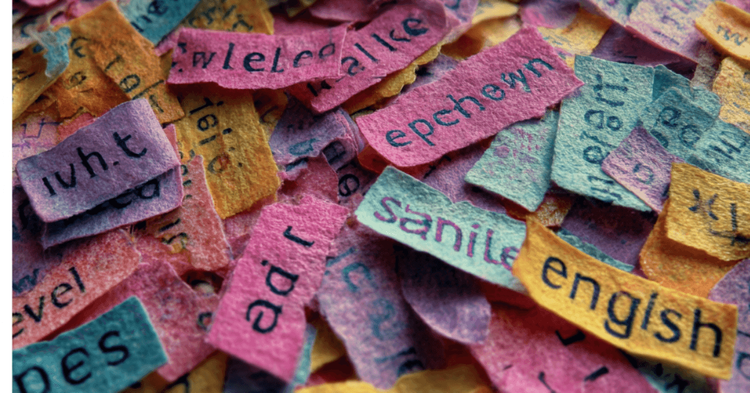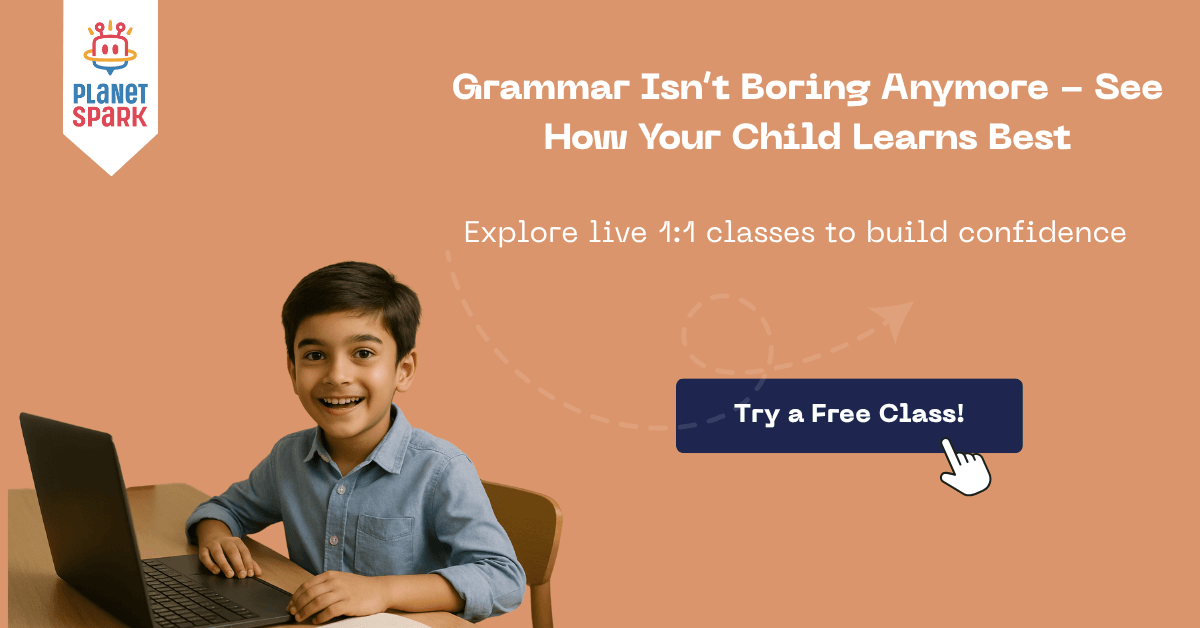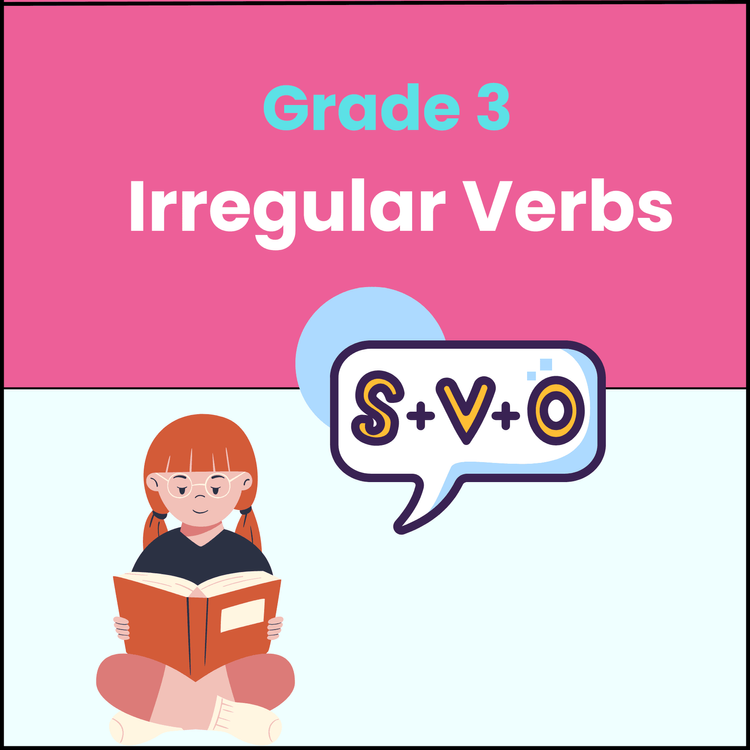Teach Interjections to Class 1 Kids with Types & Examples

Table of Contents
Interjections are sounds, words, or sentences that express the speaker's feelings or emotions. Using interjections is a crucial skill to have for Class 1 English students.
In this article, we will learn about interjections for Class 1 in complete detail. We will understand their importance, usage, and types. Plus, there's a worksheet at the end to help you practice everything you have learned.
At this age, grammar learning should feel like play, not pressure. That’s why PlanetSpark’s English Grammar Course for Kids turns grammar into an engaging experience with live 1:1 sessions, stories, games, and role-plays.
Let's begin by understanding what exactly interjections are:
What Are Interjections?
Interjections are simply words that express strong emotions or sudden feelings, like joy, grief, suffering, regret, etc. In sentence formation, interjections provide no grammatical purpose. Instead, it's an exclamation used to communicate emotions in everyday conversation.
Examples of Interjections for Class 1
Let's look at some example sentences with interjections for Class 1 students:
Hurrah! India won the match
Ah! My sister has got first division
Yay! Sweets will be distributed in the school
Wow! This car looks beautiful
Alas! He couldn't pass the examination
Ew! This looks so dirty
Oops! I missed my documents at home
Ouch! I fell off my bicycle
Sorry! I can't lend you my book
In the above sentences, the words in bold, such as Hurrah, Ah, Yay, Alas, Ew, etc., are interjections.
Master concepts like interjections in 60 days and become a pro in English Language by booking a FREE Demo Class NOW!
Rules for Using Interjections
Learning interjections becomes much easier for kids when they know a few simple rules:
Depending on the depth of the emotion the writer wants to communicate, interjections are often followed by a comma or an exclamation mark.
Interjections are frequently found at the start of sentences. They can, however, appear at any point in the sentence, including the beginning, middle, and end.
Features of Interjections
Let's have a look at the interesting features of English interjections for Class 1 students:
In sentence formation, interjections provide no grammatical purpose.
They can't usually be changed or inflected.
They do not need to be connected to the rest of the sentence.
They are highly context-dependent.
Interjections are often the first reaction, and they don't always make sense. We use them to express our immediate response to anything that affects our emotions.
Interjections are rarely used in formal speech.
The majority of them are just sounds.
Common Interjections for Class 1 Kids
Let's look at some common examples of interjections for Class 1 students:
‘Wow’ communicates delight, surprise, or admiration.
Examples:
Wow! This car looks gorgeous.
Wow! You have made a beautiful painting.
- Ouch’ communicates pain or dissatisfaction.
Examples:
Ouch! It hit my leg
Ouch! This hurts
‘Oops’ shows a negative reaction to accidentally doing something incorrectly.
Examples:
Oops, I bought the wrong book
Oops! I left my wallet at home
‘Hurrah’ conveys sudden delight at a specific outcome.
Examples:
Hurrah! I got full marks in English
Hurrah! I won the race
‘Alas’ communicates pity or grief.
Examples:
Alas! I am ruined
Alas! I lost my way
‘Oh’ indicates pain, surprise, or pleading.
Examples:
Oh! What a car
Oh! What an emotional movie
‘Bravo’ communicates admiration.
Examples:
Bravo! You played a great shot
Bravo! You performed well in the examination
‘Hello’ communicates a greeting or surprise.
Examples:
Hello! I am Mark
Hello! What are you saying?
‘Look out’ is used to advise someone to be cautious, especially in a dangerous situation.
Examples:
Look out! This road has a lot of curves
Look out! Someone is approaching
‘Hush’ is used to make someone stop talking or become quiet.
Examples:
Hush! The baby is sleeping.
Hush! Don't talk in the library.
Interjections are just the start! Make your child an expert in Grammar by booking a FREE trial Class with PlanetSpark English Language Experts!
Types of Interjections
There are two types of English interjections for 1st Class students:
Primary Interjections
Interjections such as ‘woohoo,’ ‘oops,’ or ‘huh’ have no other meanings or uses. These individual words and sounds that are only employed as interjections are called primary interjections.
List of Primary Interjections for Class 1:
Ahem
Brr
Alas
Gee
Hurray
Ouch
Wow
Yippee
Example sentences:
Yippee! I got my favorite toy.
Wow! What a view!
Secondary Interjections
Words such as ‘exactly’ or ‘finally’ belong to both interjections and other parts of speech. These words come under secondary interjections. Their meanings change when they are used as exclamations.
For example, the original definition of the word ‘Man’ is an adult male person. However, it has an entirely different connotation as an interjection. It's utilized to communicate a strong emotion like surprise or interest. E.g., Man! That looks awesome!
List of Secondary Interjections:
Cheers
Excellent
Agreed
Cool
Exactly
Nice
No
Indeed
Yes
Example sentences:
No! This is the last thing I expected to happen.
Oh, God! Are you okay?
Interjections Based on the Severity of Expressions
Interjections are divided into two categories based on whether they convey mild or intense emotion in a sentence.
Strong Interjections: These interjections convey substantial and powerful feelings. Exclamation marks usually distinguish these from the body of the sentence. Example Sentences:
Oh my god! How did this happen?
Yay! I got a new computer.
Mild Interjections: These interjections indicate milder emotions. They may simply serve as introduction expressions without being linked to any emotions. You must divide them from the rest of the statement with commas. Example Sentences:
Oh, I wasn't aware that you live here.
Well, I guess you are right.
Note: When learning English interjections in 1st Class, remember to pay attention to the context. For example:
Oh! I completely forgot your message.
Oh, thanks for coming.
Even though both sentences contain ‘oh,’ there is an obvious difference in emotional intensity. Thus, it's better to look at the context of a statement to determine the emotional impact of certain interjections.
Interjections Based on the Kind of Emotions Conveyed
Based on the kind of emotions conveyed, interjections are divided into three categories:
Volitive Interjections
Speaker’s requests, commands, and desires are conveyed with the help of volitive interjections. Volitive interjections replace ‘I want phrases. For example, you can use ‘hush’ to communicate ‘I want you to be quiet.’ Similarly, ‘shoo’ will express your wish for something to go away.
List of Volitive Interjections:
Ahem
Go
There
Please
Psst
Shh
Enough
Silence
Yo
Emotive Interjections
Surprise, delight, terror, disgust, or any other sudden reactive emotions are expressed with the help of emotive interjections.
‘I feel’ sentences are replaced with emotive interjections. For example, you can say ‘ew’ to communicate that you feel dirty about something. Similarly, ‘ouch’ will convey that you feel pain.
List of Emotive Interjections for Class 1:
Ah
Aw
Ouch
Ew
Good
Phooey
Rats
Huzzah
Ugh
Eek
Phew
Cognitive Interjections
Cognitive interjections are utilized to express the sensations and emotions that people encounter and comprehend during their lives.
For example, the interjection ‘oh my’' can be used instead of ‘I am surprised by this unexpected thing.’
List of Cognitive Interjections:
Aha
You don’t say
Alas
Bingo
Gosh
Huh
Oh
Hmm
Whoa
Make Grammar Come Alive with PlanetSpark
Teaching interjections and other grammar topics to young learners doesn’t have to be dull! At PlanetSpark, we make grammar fun, interactive, and meaningful for kids through our English Grammar Course. Whether your child is learning to say “Wow!” or crafting full sentences, our platform ensures strong foundational skills with real-world usage.
Key Benefits of PlanetSpark’s Grammar Course:
Interactive Grammar Learning – No Rote Learning
Kids explore grammar through stories, role plays, and fun error correction—not boring rule cramming.Concept to Application Model
Lessons move step-by-step from rules to real usage—ending with writing tasks and live correction.Gamified Learning Tools
Children love learning through quizzes, word puzzles, and online games like Kahoots.Integrated Writing Practice
Grammar concepts are reinforced through sentence-building and paragraph writing exercises.Progressive Levels of Proficiency
From basic topics like interjections, nouns, and verbs to advanced grammar—students grow at their own pace.Detailed Parent Reports
Get clear insights on your child’s sentence complexity, writing fluency, and grammar accuracy.
Build grammar confidence early!
Enroll your child in PlanetSpark’s Grammar Program Today
Interjection Worksheets/Exercises with Answers for Class 1
Fill in the blanks with the right option.
____! The car is missing.
____! She has won the lottery.
____! Did he fail?
____! You have caught the thief.
____! You have played well.
____! You have won the game.
____ You are nearing the goal.
____! I am never doing that again!
____! The show is about to start.
____! Stop messing with me.
____! The child is sleeping.
____! Never go outside in the dark.
____! Someone is knocking at the door.
____! The movie was so disgusting.
Answers
Good Heavens! The car is missing.
Good God! She has won the lottery.
What! Did he fail?
Well done! You have caught the thief.
Bravo! You have played well.
Splendid! You have won the game.
Back up! You are nearing the goal.
Ugh! I am never doing that again!
Shh! The show is about to start.
Hey! Stop messing with me.
Hush! The child is sleeping.
Look! Never go outside in the dark.
Hark! Someone is knocking at the door.
Ew! The movie was so disgusting.

Conclusion
In the above post, we looked at some examples of interjections for Class 1 students. These phrases of speech are categorized into various types depending on their usage.
Because there are so many interjections in English for Class 1 students, hearing them is the best way to learn them. Parents that want to make their children proficient in interjections should frequently use them in daily conversation. This will allow kids to explore a wide range of words and sounds to convey many emotions at an early age.
FAQs: Teach Interjections to Class 1 Kids
Q. Why do we use interjections?
A. Interjections are used to indicate emotions such as excitement, joy, surprise, enthusiasm, or disgust.
Q. When should interjections be used?
A. You may use interjections in a dialogue between characters in a book, or informal writing, like emailing, blogging, or texting family and friends. Interjections are rarely if ever, employed in formal writing, such as corporate or academic writing.
Q. Which interjection would you use to convey excitement?
A. You can use the following interjections to express joy and excitement:
Yay
Hooray
Yippee
Woohoo
Q. Give some examples of primary interjections.
A. Examples of primary interjections for Class 1 include:
Aha
Drat
Alas
Boo
Geez
Huzzah
Oh
Pfft
Ugh
Yum
Yahoo
Q. Explain the use of ‘ah’ as an interjection.
A. 'Ah' communicates surprise, realization, pleasure, or resignation.
Examples:
Ah, now I get it.
Ah, this seems good.
Download Free Worksheets
Personalized Communication Report
Record a video to get a AI generated personalized communication report for your child

Hi There, want to try these
tips for your child with
LIVE with our expert coach?
Let's check your child's
English fluency

